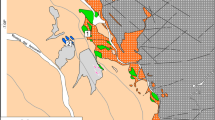Abstract
An X-ray diffraction study of vermiculitized micas in ultramafic and mafic intrusive rocks from Cheongyang, Korea, shows the following weathering sequence: mica → ordered mica/vermiculite interstratification → vermiculite. Electron microprobe analyses show the general trends of K leaching and Ca enrichment with increased weathering. The vermiculitization of phlogopite from ultramafic rocks proceeds by means of a continuous decrease in Al-for-Si tetrahedral substitutions and a progressive increase in Al-for-(Fe2+ + Mg) octahedral substitutions in the early stage of weathering. These substitutions occur to compensate for the excess of negative charge in the mica-like layer, in agreement with currently accepted vermiculitization mechanisms. They change to a slight increase of Al-for-Si tetrahedral substitutions in the late stage of the vermiculitization of phlogopite, owing to the oxidation of Fe despite its low content. However, the behavior of Fe in the late stage of the transformation of biotite into vermiculite is significantly different; that is, Fe increases substantially. The reason for this Fe increase in the late stage remains unresolved. Recalculations of the structural formulas on the basis of several assumptions indicate that the oxidation of Fe is necessary for the vermiculite derived from biotite to form the reasonable structural formulas.
Similar content being viewed by others
References
April, R. H., Hluchy, M. M., and Newton, R. M. (1986) The nature of vermiculite in Adirondack soils and till: Clays & Clay Minerals 34, 549–556.
Bain, D. C., Mellor, A., and Wilson, M. J. (1990) Nature and origin of an aluminous vermiculitic weathering product in acid soil from upland and catchments in Scotland: Clay Miner. 25, 467–475.
Banfield, J. F. and Eggleton, R. A. (1988) Transmission electron microscope study of biotite weathering: Clays & Clay Minerals 36, 47–60.
Bence, A. E. and Albee, A. L. (1968) Empirical correction factors for the electron microanalysis of silicates and oxides: J.Geol. 76, 382–403.
Coleman, N. T., Le Roux, F. H., and Cady, K. G. (1963) Biotite-hydrobiotite-vermiculite in soils: Nature 198, 409–410.
Fordham, A. W. (1990a) Weathering of biotite into dioctahedral clay minerals: Clay Miner. 25, 51–63.
Fordham, A. W. (1990b) Treatment of microanalyses of intimately mixed products of mica weathering: Clays & Clay Minerals 38, 179–186.
Fordham, A. W. (1990c) Formation of trioctahedral illite from biotite in a soil profile over granite gneiss: Clays & Clay Minerals 38, 187–195.
Foster, M. D. (1960) Interpretation of the composition of trioctahedral micas: Geol. Survey Prof. Paper 354-B, 11–48.
Ildefonse P., Manceau, A., Proust, D., and Groke, M. C. T. (1986) Hydroxy-Cuvermiculite formed by the weathering of Febiotites at Salobo, Carajas, Brazil: Clays & Clay Minerals 34, 338–345.
Kim, H. Y. (1992) Mineralogical and chemical study of the vermiculites in the weathering profile, in the Cheongyang area: MSc. thesis, Yonsei University, 57 pp. (unpublished, in Korean).
Kiss, E. (1967) Chemical determination of some major constituents in rocks and minerals: Analy. Chim. Acta 39, 223–234.
MacKenzie, R. C. (1958) The evaluation of clay mineral composition with particular reference of smectites: Silicates Industries 25, 12–18.
Meunier, A. and Velde, B. (1979) Biotite weathering in granites of western France: in Proc. Int. Clay Conf., Oxford, 1978, M. M. Mortland and V. C. Farmer, eds., Elsevier, Amsterdam, 405–415.
Newman, A. C. D. and Brown, G. (1987) The chemical constituent of clays: in Chemistry of Clays and Clay Minerals, Monograph No. 6, A. C. D. Newman, ed., Mineralogical Society, London, 1–128.
Proust, D., Eymery, J. P., and Beaufort, D. (1986) Supergene vermiculitization of a magnesian chlorite: Iron and magnesium removal processes: Clays & Clay Minerals 34, 572–580.
Reynolds, R. C. (1980) Interstratified clay minerals: in Crystal Structures of Clay Minerals and Their X-ray Identification, G. W. Brindley and G. Brown, eds., Mineralogical Society, London, 249–303.
Rhoades, J. D. and Coleman, N. T. (1967) Interstratification in vermiculite and biotite produced by potassium sorption: I. Evaluation by X-ray diffraction pattern inspection: Soil Sci. Soc. Amer. Proc. 31, 366–372.
Song, Y., Kwon, I. S., and Moon, H. S. (1990) Mineralogy of vermiculite occurring in the Cheongyang area: J. Miner. Soc. Korea 3, 60 (in Korean).
Author information
Authors and Affiliations
Rights and permissions
About this article
Cite this article
Moon, HS., Song, Y. & Lee, S.Y. Supergene Vermiculitization of Phlogopite and Biotite in Ultramafic and Mafic Rocks, Central Korea. Clays Clay Miner. 42, 259–268 (1994). https://doi.org/10.1346/CCMN.1994.0420304
Received:
Accepted:
Published:
Issue Date:
DOI: https://doi.org/10.1346/CCMN.1994.0420304




